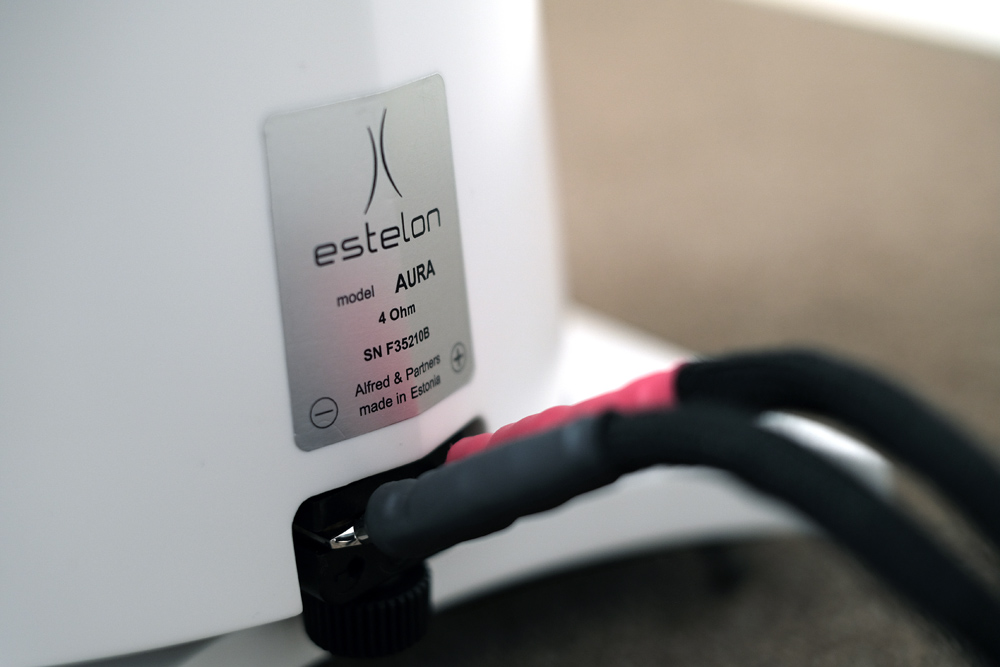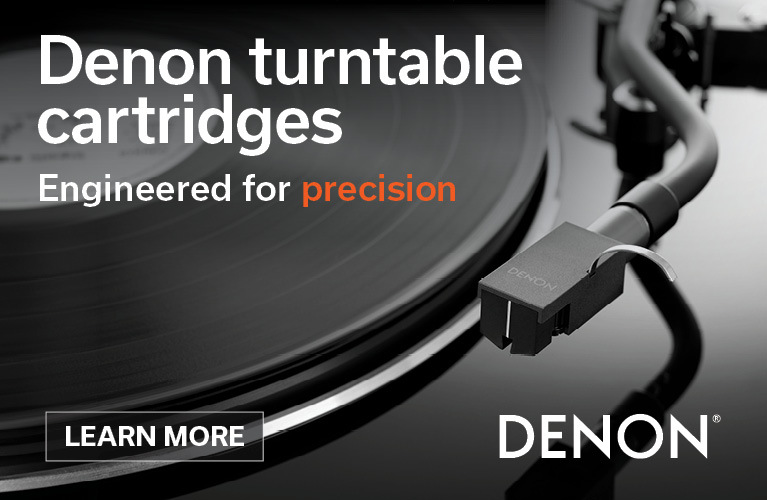When I heard Estelon’s brand new AURA speakers at High End Munich 2023, I thought, “Note to self: These, I need to review.” In a rare experience, AURA presented the most ‘outside the speakers’ enveloping soundfield I’d heard at any show. Anywhere. Ever. And then there was that auric glow, that magnetic attraction from what, in my humble opinion, must be one of the most striking loudspeaker designs in high-end audio. Well, some months after that memorable show encounter, AURA materialised in my listening room, aglow in radiant white. Will AURA sonically enchant as it did at that remarkable Munich showing?
Strike a Pose
Can the eyes bias the ears? That was a question I kept asking myself just prior to the AURA’s delivery. I was thoroughly pre-smitten by both the extraordinary audition in Munich and the speakers’ gorgeous near-organic curvaceous design. In my head, the debate concluded with a resounding… possibly, but only temporarily. I’ve had many beautiful speakers in my listening studio, some exhibited magnificent Italian flair, or flaunted a standout design, while others flashed exotic finishes. I found that, after prolonged listening, the visual aspect’s influence on the ear progressively begins to fade, like a lens drifting out of focus. I then start listening analytically, only succumbing to more impulsive, subjective enjoyment if a design is truly outstanding.
It was very much that way once I dived into the listening sessions post-delivery. But first, a quick description of the unpacking and setup. The speakers come boxed individually, with one box housing the high quality cone spiking system for both speakers. Once unpacked, undressed (AURA arrives frocked in a tailored full white cotton protective sleeve), and fitted with the spiking system, positioning AURA is as simple as single-handedly walking it into place – meaning one person, not one-handed unless you’ve mastered object levitation. Actually, there is such thing as acoustic levitation, but that’s another review altogether. Yeah, it’s not an overtly heavy speaker.
I played around with precise location, yet they ended-up in roundabout the same position most speakers end-up in within my room. It’s approximately 1.4m to the baffle from the wall behind the speakers, 0.80m from the side walls to the tweeter and about 2.5m apart measured from tweeter to tweeter. Those dimensions reap a great balance of low-frequency neutrality, depth, weight and tightness while also attaining excellent spatial qualities.

AURA’s svelte figure arrays an MTM driver configuration on its subtly curved front baffle. The central driver is a Scan-Speak 26 mm (1 inch) ‘Illuminator’ soft dome tweeter sporting a powerful ‘symmetrical drive’ magnet system. It’s mounted within a machined shallow-flared oval waveguide which, due to its geometry, is said to provide optimum dispersion, smoother inter-driver transition, and enhanced sensitivity. Estelon states the waveguide has a “complex elliptical shape” which has been specifically designed for the Scan-Speak tweeter within the AURA context. The tweeter is protected from kiddie fingers with a metal mesh grille.
The ‘Satori’ dual mid-bass drivers are a top-tier design from SB Acoustics. The 130 mm (5 inch) drivers feature a vented “aerodynamic” cast aluminium chassis/basket and a powerful, low distortion neodymium magnet motor system. The Satori drivers’ ‘Egyptian Papyrus’ cone material is extremely lightweight, something that, in conjunction with the soft/low dampening rubber roll surround, promises good transient response. From my experience, these Satori drivers present a very natural tonal balance.
AURA is a trickster with a hidden card up its slender sleeve. Within the sculptured, curvy sealed cabinet hides a trump card which elevates the mid-sized supermodel to the prestigious catwalks of larger designs. Within the lower third of AURA’s cabinet innards, Estelon’s founder (co-founded with daughter and CEO Alissa Vassilkova) and Chief Designer Alfred Vassilkov and his engineers have mounted a high power down-firing 250 mm (10 inch) woofer tasked with handling the low-frequencies. The woofer, sourced from Italy’s Faital, features a “semi-pressed” paper diaphragm, and is designed to provide extended low frequencies, with additional support coming from floor proximity coupling.
Estelon has invested considered effort in the design of the 3-way crossover network. Both in terms of incorporating the company’s philosophies and the component quality. Said components include, from Alfred Vassilkov himself, “Auricap capacitors and Mundorf copper wire coils. Additionally, we incorporate Mundorf Supreme resistors to ensure optimal signal transmission and fidelity. Furthermore, our attention to detail extends to the connectors, where we utilise Cardas connectors known for their reliability and precision”.

Back to that down-firing woofer: the driver’s placement within the cabinet’s volume naturally creates a low-pass filter with a steeper curve than “the electrical filter, therefore the higher frequencies that are produced by the bass driver, at around 80Hz, are eliminated”, as Estelon describes. This provides a more controlled handover to the mid-bass drivers. Estelon has selected quality silver cabling for the interface between the network and drivers by renowned specialist Kubala-Sosna from the US of A.
The organically rounded “resonant-free” cabinet is machined from a very rigid, proprietary mineral-filled “thermoformed composite” material. In addition, the cabinet is further reinforced with braces and sub-chambers. Interestingly, Estelon uses a different marble-based material for its other models. I was curious as to the reasons behind this construction material, so I contacted Chief Designer Alfred Vassilkov for some deeper detail.
The decision to use thermoformed composite material for AURA's cabinet was driven by a combination of factors. The thermoformed composite offers distinct advantages in terms of cost-effectiveness and production simplicity. This enables us to streamline manufacturing processes and ultimately offer a more accessible product without sacrificing quality.
Regarding the internal architecture, AURA's design incorporates several key features: The AURA cabinet has a reinforced front panel engineered to support the mid-range woofers and tweeter drivers. This reinforcement reduces vibrations. The AURA employs 2 separate chambers, 1 for the upper drivers (mid-range woofers/tweeter), and 1 for the woofer. We have strategically placed internal components to stiffen the cabinet structure, minimising resonance and improving stability.
Our goal with the AURA was to create a speaker that balances the Estelon top quality with affordability. The use of thermoformed composite material, alongside careful attention to internal architecture, allows us to achieve this balance effectively.
I went on to seek further information on the AURA drivers:
Our speaker design philosophy is rooted in a meticulous approach that prioritises several key factors. First and foremost, we focus on selecting and combining drivers that complement each other seamlessly. Each driver is chosen for its specific characteristics and the way it contributes to the overall sound. We test many drivers from many different brands and we chose what fits our sound.
Secondly, we create optimal conditions within the cabinet for each driver to perform at its best. This involves carefully designing the internal layout and structure to minimise interference and maximise efficiency. Our goal is to balance the above parameters by carefully fine-tuning the drivers, optimising cabinet conditions, and refining the crossover design.
AURA speakers have introduced are beautiful design language which would seem like a progression of the YB model and an evolution of the Estelon signature look in general. Estelon even refers to it as a “New Era”. I wondered if this new aesthetic would be translated to larger models in the Estelon catalogue.
The AURA model represents a continuation of our commitment to crafting speakers that seamlessly blend into living spaces while delivering outstanding audio performance. Our focus is on creating speakers that not only sound exceptional but also enhance the aesthetic appeal of any room. The design ethos behind AURA is centred on simplicity and flexibility. We've opted for a sleek, minimalist shape that complements a wide range of interior styles. By prioritising a slim and unobtrusive form factor, we provide our customers with greater flexibility when it comes to placement and installation. We are excited about the future of AURA and have extensive plans to expand the line with additional models.
Finally, I asked Vassilkov about his main targets for AURA’s performance. In other words, what was he seeking in terms of sonic qualities to differentiate AURA from its Estelon siblings?
Our goal with AURA was to deliver big sound in a small form factor, making it the ideal solution for living rooms where space is often at a premium. To achieve this, we designed AURA with a powerful down-firing and two mid-range drivers, aiming to enhance the overall power and presence of the sound. This configuration allows AURA to deliver rich and immersive audio experiences, filling the room with detailed and dynamic soundscapes.
AURA is available in a wide palette of tones. While the review sample was provided in an arresting matt white, Estelon also offers gloss black and, more recently, the company has released a number of additional colours. Estelon can also custom colour match to your specification for an extra charge.
A final word on the AURA design in general. As far as loudspeakers, AURA’s unique form is pure… audio glamour. The subtle curves, the cohesive angles, the complimentary arches, and the delicate bow all make for a singular expression of masterful industrial design. That carries through to the hardware – like the binding posts, etc. – which has been employed to compliment the overall feel of quality. Even the grilles, with their sharp lines starkly contrasting AURA’s gentle curves, somehow cohere and elevate the overall look. Super-kudos Estelon.
Sonic Youth
The refinement I’m accustomed to hearing at my various auditions/experiences with Estelon speakers – including the superb X Diamond Mk.II I reviewed here – was evident with AURA. AURA may be a young speaker, but its producers’ engineering maturity is clearly evidenced in the new design.

OK, let’s cut to the chase. While AURA is a very good speaker all-round, as you’ll read anon, the one thing that this speaker does better than just about any other I’ve heard, is the representation of a recording’s soundfield. As stated above, it’s what bowled me over in Munich in 2023 at AURA’s launch. The cliché stands: this is a totally insane disappearing act. Where are the speakers? In an appropriate room (the best speaker in the world cannot defeat poor acoustics) AURA will throw a massive soundstage and project super-focused images entirely outside and beyond its stunning cabinets. It’s quite the faultless spatial reproduction act.
Play any well-recorded live album and you’ll be rewarded with a spaciousness, an open, panoramic aural view of vast dimensions. There’s no congestion, usually a thing that happens in the midrange, which goes on to ruin the illusion. AURA just presents free, out-of-the-box, spatially natural sound that can be captivating.
Once again, the remarkable spatial reproduction powers of AURA proved themselves with large orchestral works. I have a healthy collection of Deutsche Grammophon German pressings featuring quintessential performances by the London Symphony, Berliner Philarmoniker, and others, under the batton of von Karajan, Rostropovich and Abbado. Mozart’s Klavierkonzert No. 21 and 23 with Rudolf Serkin on piano and Claudio Abbado conducting the London Symphony Orchestra was breathtakingly enormous and presented the various instrument groups in stunning 3D panoramas.

The classic recording of Elgar’s Cello Concerto with Du Pré with the London Symphony Orchestra, this time under Sir John Barbarolli’s guidance, almost brought tears to my eyes. Whether it was Du Pré’s solo sections or when the full orchestra comes in with majestic dynamic swing, AURA envelops you in the soundfield. The speakers also capture the beauty and control of Du Pré’s cello mastery in a way that engaged me, moving me – especially knowing the tragic background story.
AURA may be a slimline speaker with inherent internal volume constraints, but it nevertheless does convincing bass for the size. The woofer’s placement and the resultant floor reinforcement end up producing satisfying low frequencies. I enjoyed listening to bass instrument masters like Ray Brown (Live at the LOA – Summer Wind), Brian Bromberg (Wood), Renaud García-Fons (Solo: The Marcevol Concert), Nenad Vasilić (The Art Of The Balkan Bass), Adam Ben Ezra (Can’t Stop Running) and many others.
AURA delivered a tight and nuanced low-end with great transient attack (or speed as audiophiles refer to it). Plus, it’s a clever engineering trick that, given the position of the woofer in relation to the other drivers above it, there’s excellent cohesion on offer. And that gelling, that interconnection of the drivers, is also what renders that massively spacious, seamlessly uniform soundfield. Kudos, again, to Vassilkov and team.
Vocalists’ presentation throughout the midrange energy band is very marginally laid back. This perspective made closed mic’ed, hot sounding vocals somewhat tamer without affecting the overall sense of immediacy. It’s just a different viewpoint, a diverse aspect which is neither right nor wrong… unless it is for you, as an element of your subjective preference. Of course, this perspective enhanced the depth layer aspect in terms of image placement.

AURA’s presentation of the treble range is balanced expertly with the midrange, despite it being a superbly detailed tweeter. Plus, the shallow waveguide’s resultant sensitivity increase delivers smooth nuances and fast transients. Steel guitar strings show subtleties in finger play in a natural way; it’s not overhyped detail, it’s just what you’d naturally hear with the live instrument. Dan Patlansky’s bottleneck guitar-playing technique on the intro for “Bring The World To Its Knees” from his Wooden Thoughts album had excellent detail, micro-dynamics, and resonance. Once the band joins in, the drummer’s snare had proper snap and bite while the electric bass provided a consistent rhythmic pace.
I think AURA loves power too. Crank the volume up a tad and the bass and dynamics project forth even more satisfyingly. In a small-ish to mid-sized room, you’ll not want for more.
Conclusion
AURA is a somewhat uncommon phenomenon in the high-end loudspeaker space. It’s a pure and refined artistic expression from a company also renowned for its technical prowess. It strongly combines solid engineering with a creatively unique aesthetic.

Yet, the styling is not a mere vanity exercise, no, AURA’s shape also contributes to technical aspects such as on-axis/off-axis response and dispersion characteristics leading to superior spatial performance. Elegance and aesthetics aside, the speakers feature reassuringly rigid cabinets employing quality drivers and crossover network components which, as potent utensils all combined in the hands of Estelon’s skilled engineers, have amounted to excellence. AURA plays bigger than it looks and is more than capable in all key areas of performance while, in my view, being among the very best in terms of spatial presentation.
Yes, with this outstanding speaker, Estelon has undoubtedly shown that AURA’s energy can indeed have a very powerful impact on music’s splendour.
… Edgar Kramer
This email address is being protected from spambots. You need JavaScript enabled to view it.
Associated Equipment
- Speakers— Wilson Audio Alexia V, Axis Loudspeakers VoiceBox S (nearfield monitor), Vermouth Audio Little Luccas Mk.II, Atacama stands
- Amplifier— Gryphon Audio Antileon EVO
- Preamplifier— Supratek Cortese, Totaldac d1-triunity (direct to amplifier)
- Sources— Digital:432 EVO Aeon Mk.3 Reference Music Server/Roon Core, Yamaha CD-S2100 transport, Totaldac d1-triunity DAC. Analogue: Transrotor Crescendo with Konstant Studio controller, Reed 1X Tonearm with upgraded internal wiring, Shelter Harmony cartridge, The Funk Firm Houdini cartridge decoupler, Supratek Cortese & REDGUM Audio RGPH2 phono stages
- Processor— DEQX PreMate (part of arsenal/casual use)
- Cables— VYDA Laboratories Orion Silver Reference HFC IC and speaker cables, PSC Audio custom design XLR, Vermouth Audio Reference loom,ZenSati Zorro, Tubulus Concentus USB
- Audio Rack— SGR Audio Statement Model V, Aspire Audio Belgravia amplifier platform (customised for Gryphon Audio Antileon EVO), Stereotech Aluminar Dark 3-tier rack
- Acoustic Treatment— Vicoustic Multifuser Wood, Wavewood Ultra, Cinema Round Premium and Super Bass Extreme
- Miscellaneous— Silent Angel Bonn N8 Pro network switch, GigaWatt PF-1 EVO power strip, Les Davis Audio Viscoelastic CLD discs, Voodoo Cable Iso-Pods, Bocchino Audio Mecado, VRC Vinyl Record Cleaning systemplus miscellaneous accessories
Estelon AURA Loudspeakers
Price: AU$25,999
Australian Warranty: Five Years
Australian Distributor: Advance Audio Australia
+61 2 9561 0799
www.advanceaudio.com.au
Estelon – Alfred & Partners OÜ
Kukermiidi 6 Tallinn 11216
Estonia
+372 661 0624
www.estelon.com












